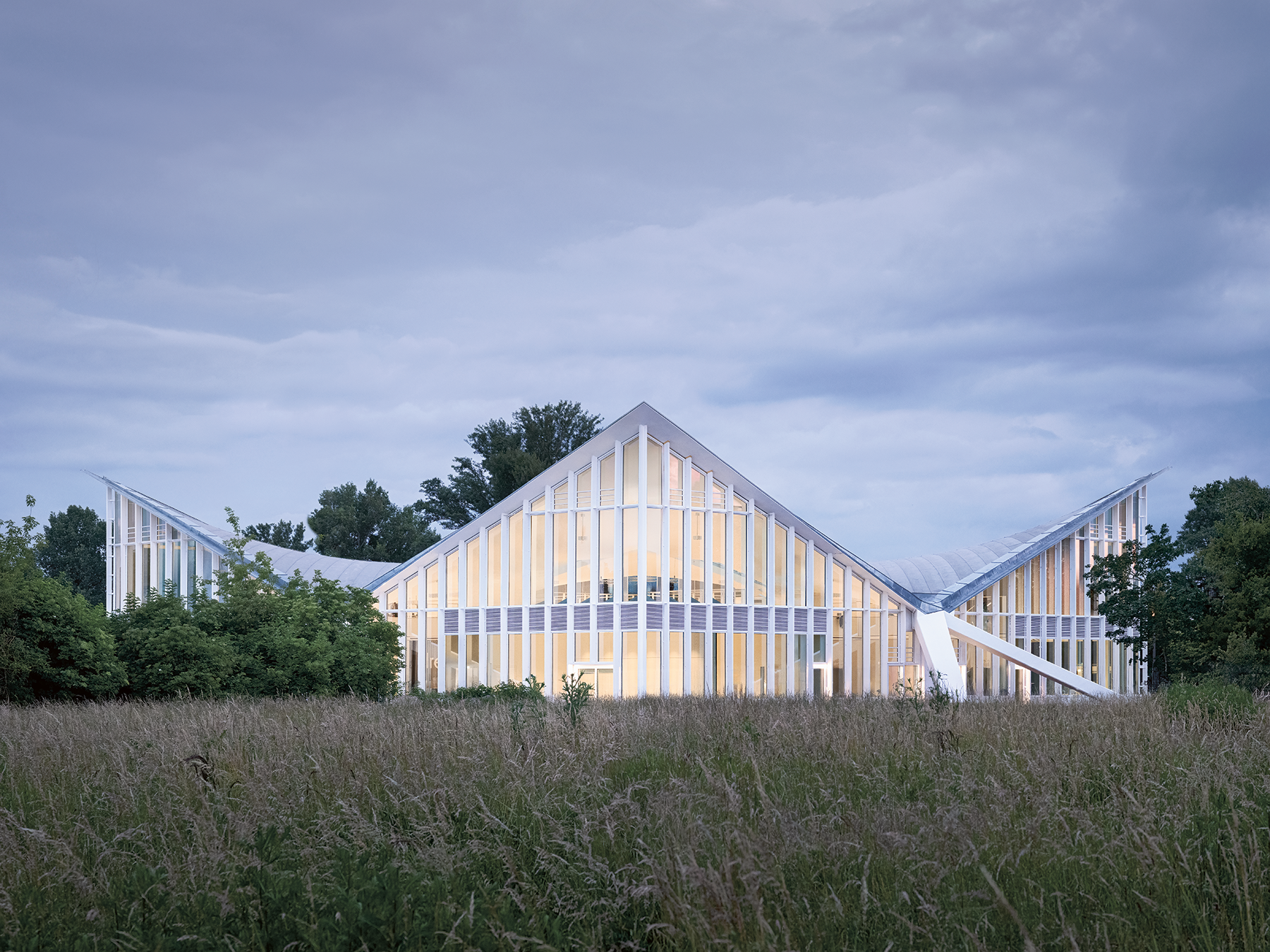
改造设计 gmp
1969年设计 乌尔里希·穆特
项目地点 德国
完成时间 2024年
本文文字由gmp提供。
两项干预措施让乌尔里希·穆特在马格德堡的双曲面壳体屋顶建筑遗址免遭拆除,并再次焕发出面向未来的活力。最新的碳纤维混凝土技术恢复并提高了这个充满想象力的壳体屋顶的荷载能力。巨大的室内空间被划分为更灵活的小空间,同时保留了令人印象深刻的大跨度屋顶所带来的壮观效果。
It took two interventions to save the ruins of Ulrich Müther’s Hyparschale in Magdeburg from demolition and restore it to a future-ready state. The load-bearing capacity of the visionary roof shell was reestablished and even improved thanks to state-of-the-art carbon concrete technology. The large interior was subdivided into smaller rooms for more flexible programming, without diminishing the imposing impression made by the broad roof above.
▲ 项目视频 ©Lukas Schmid
1969年—2017年
马格德堡双曲面壳体屋顶建筑是民主德国极富创造力的建筑工程师乌尔里希·穆特(Ulrich Müther,1934年—2007年)保存至今的规模最大的作品。他的标志性设计是双曲屋面,即双曲抛物面,通过曲面自行承重,以极少的建筑材料跨越宽阔的无柱空间。穆特将其称为“Hyparschale”。
The “Hyparschale” in Magdeburg is the largest remaining hall roof by the man who was arguably East Germany’s most inventive structural engineer, Ulrich Müther (1934 – 2007). His trademark was the double-curved roof surfaces, or “hyperbolic paraboloids” supported by their own curvature, which allowed the roof to span extremely wide spaces without columns and using very little material — for which Müther chose the term “hyparschale.”
穆特在马格德堡双曲面壳体屋顶建筑中挑战了当时的技术极限。他不仅想用一个双曲抛物面壳体覆盖48米见方的平面面积,还要将屋顶分成大小相同的四块,每块屋顶都是正方形平面的双曲抛物面。屋顶单元之间的空隙由玻璃砖补充,在大厅中心汇成一个星形的天窗。
For his Magdeburg Hyparschale, Müther pushed the technological possibilities of his day to their limits. He not only wanted to span a 48-square-meter area with a doublecurved roof slab without supports, but he also wanted to subdivide the roof surface into four equal subparts, each suspended over a square floor plan and each of which was double-curved into itself. Between these roofs, he installed fenestration bands that came together at the center of the hall to form a star-shaped rskylight.
就当时的建筑技术而言,屋顶上星形天窗的构想过于大胆。尽管屋顶承重不是问题,但玻璃砖带来了大厅内的渗水问题。开放后不久,天窗用沥青纸材料全部封闭。穆特在设计中追求的那种通透、轻盈及纤薄的大厅屋顶效果消失殆尽。随着时间的推移,薄壳混凝土屋顶出现了多处裂痕,加固钢筋也开始生锈。1997年,由于严重的坍塌隐患,建筑被封闭并计划拆除,但民众和国际专家们的抗议让人们意识到了这一独特结构的建筑文化价值,并最终拯救了这座壳体结构。在未能找到私人投资者的情况下,马格德堡市于2017年决定自行对建筑进行修复工作。
The idea of a star-shaped skylight was considered too daring for the structural possibilities of the time. Although the roof held up, water seeped between the bands of glass components and dripped into the hall. Shortly after it was opened, the skylights were completely sealed with tar paper, putting an end to Müther’s intended effect of a transparent, lightweight, and elegant hall roof. Over the years, the thin concrete roof also broke off in a number of places and the reinforcing steel rusted. Faced with an imminent threat of collapse, the Hyparschale was closed in 1997 and slated for demolition. Protests were held by citizens and international experts who cited the architectural value of this unique structure and ultimately succeeded in saving the shell. After failing to find private investors, the City of Magdeburg itself decided to refurbish the Hyparschale in 2017.
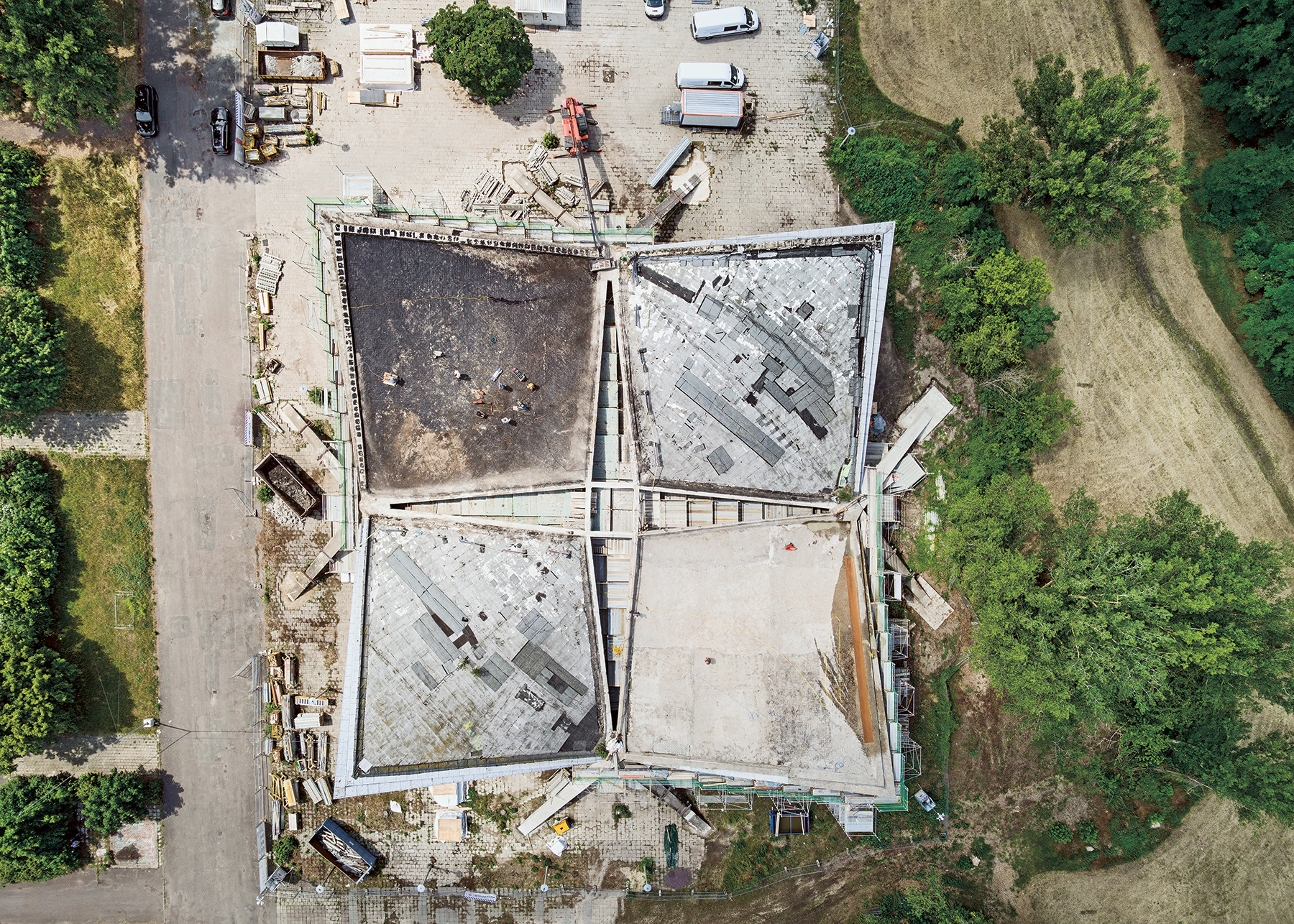
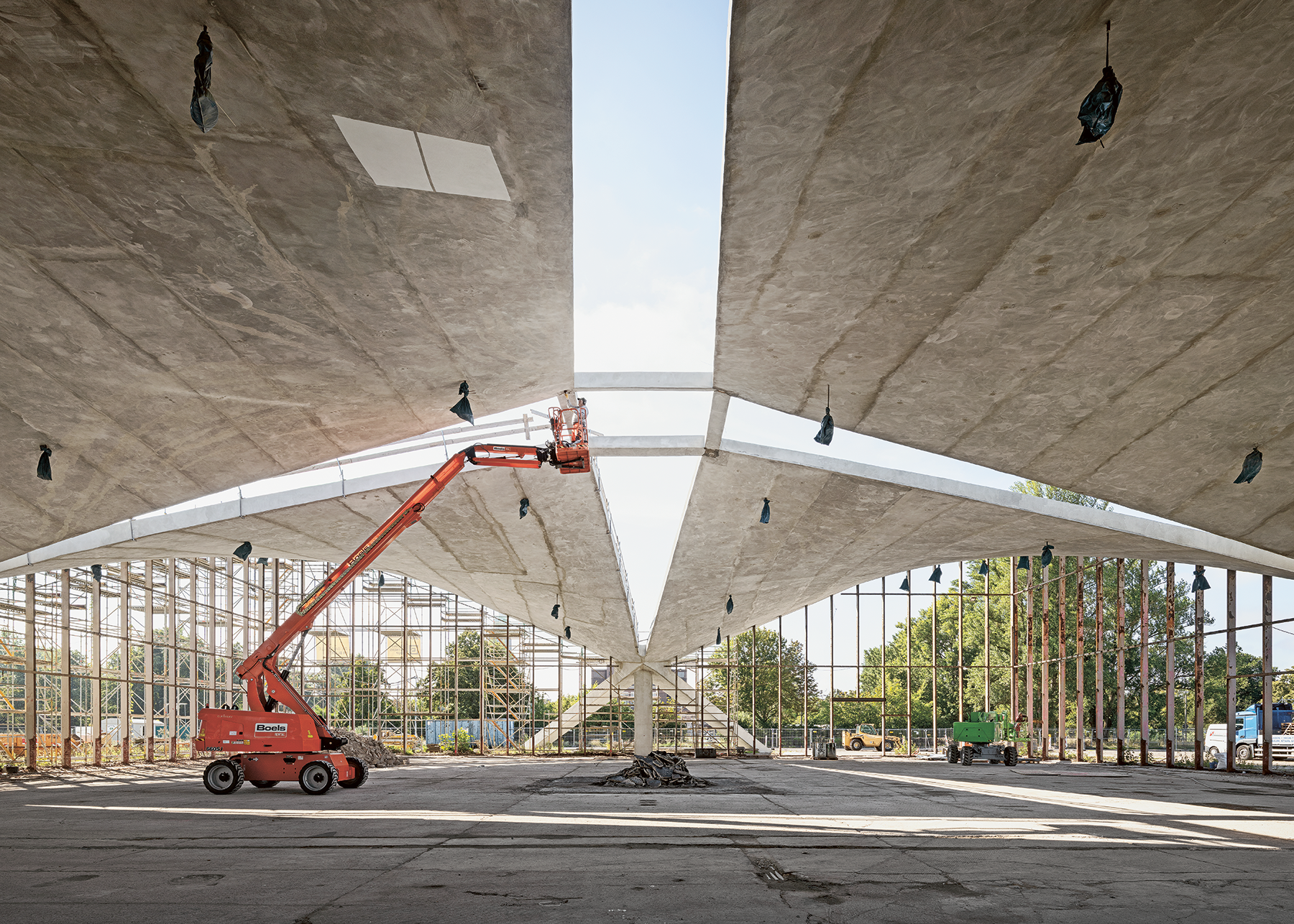
2017年—2024年
我们与Prof. Rühle, Jentzsch及合伙人事务所的工程师、德累斯顿Carbocon公司的碳纤维混凝土专家,以及德累斯顿工业大学重型结构研究所合作,提出了用碳纤维混凝土来修复屋顶的新型修缮改造方案。首先将现有屋顶内、外表面都打磨粗糙,以便涂上两层薄的特质混凝土层,特质混凝土层内铺设了由碳纤材料编制成的网格。这样,壳体内、外各加建了最厚为10毫米的具有抗腐蚀性的加固层。这种方法在不改变屋顶规模的情况下,甚至增加了结构的承重能力。建筑天窗也终于重见天日。
Together with the engineering firm of Prof. Rühle, Jentzsch und Partner, the Dresden-based carbon concrete specialists from Carbocon, and the Institute of Concrete Structures at Technical University Dresden, we developed a proposal for using a new refurbishment process to save the Hyparschale that involved repairing the roof with carbon concrete. The existing roof was roughened inside and out so that two thin layers of special concrete can be applied, in which carbon fiber textiles are placed. The result was a corrosionresistant layer with a total thickness of maximum 10 mm on both sides of the roof panels that also served to increase the structure’s load-bearing capacity without changing the dimensions of the wide-span and therefore extremely thin skin of the roof. As a consequence, the fenestration bands provided by Müther could be permanently uncovered.

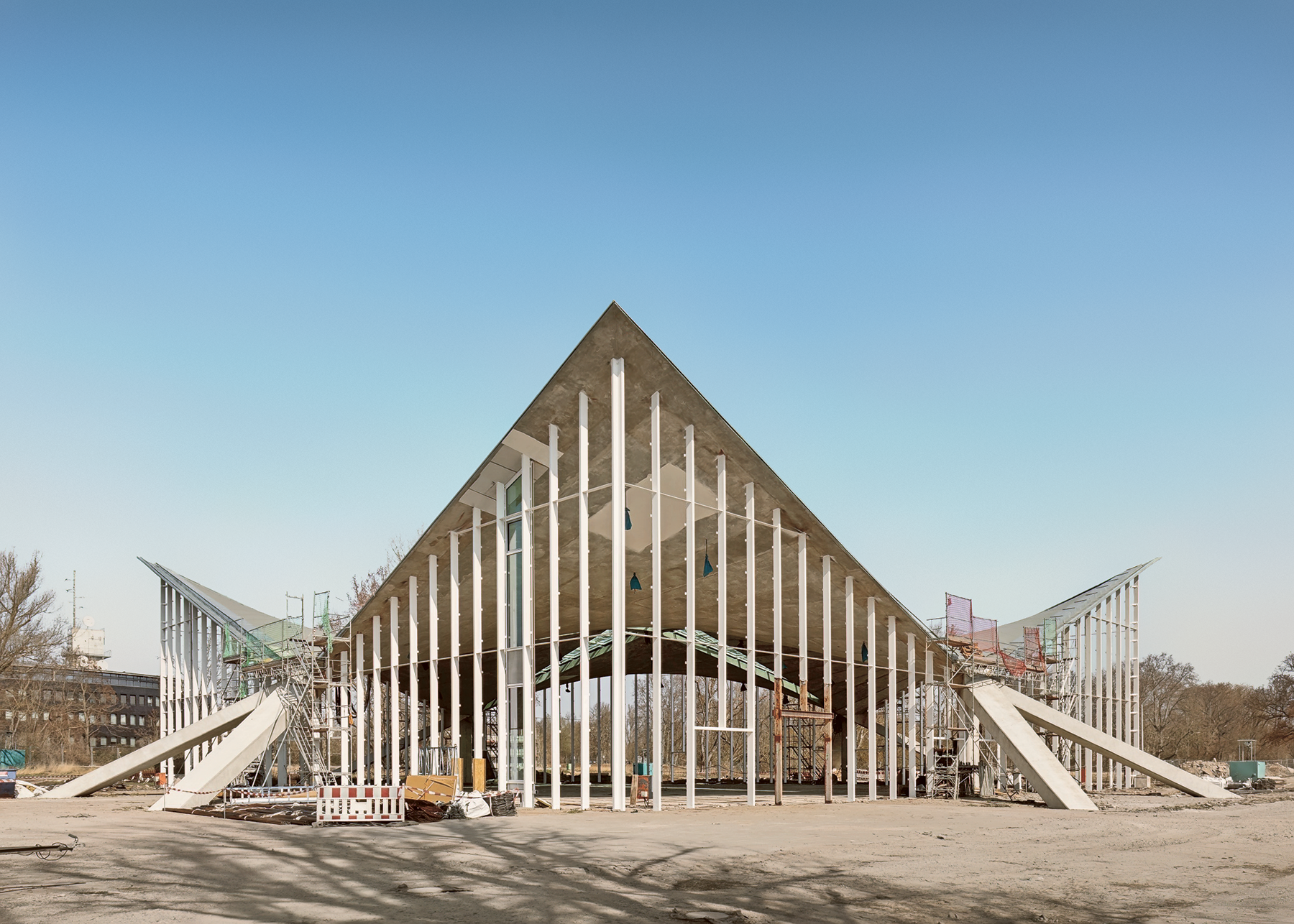
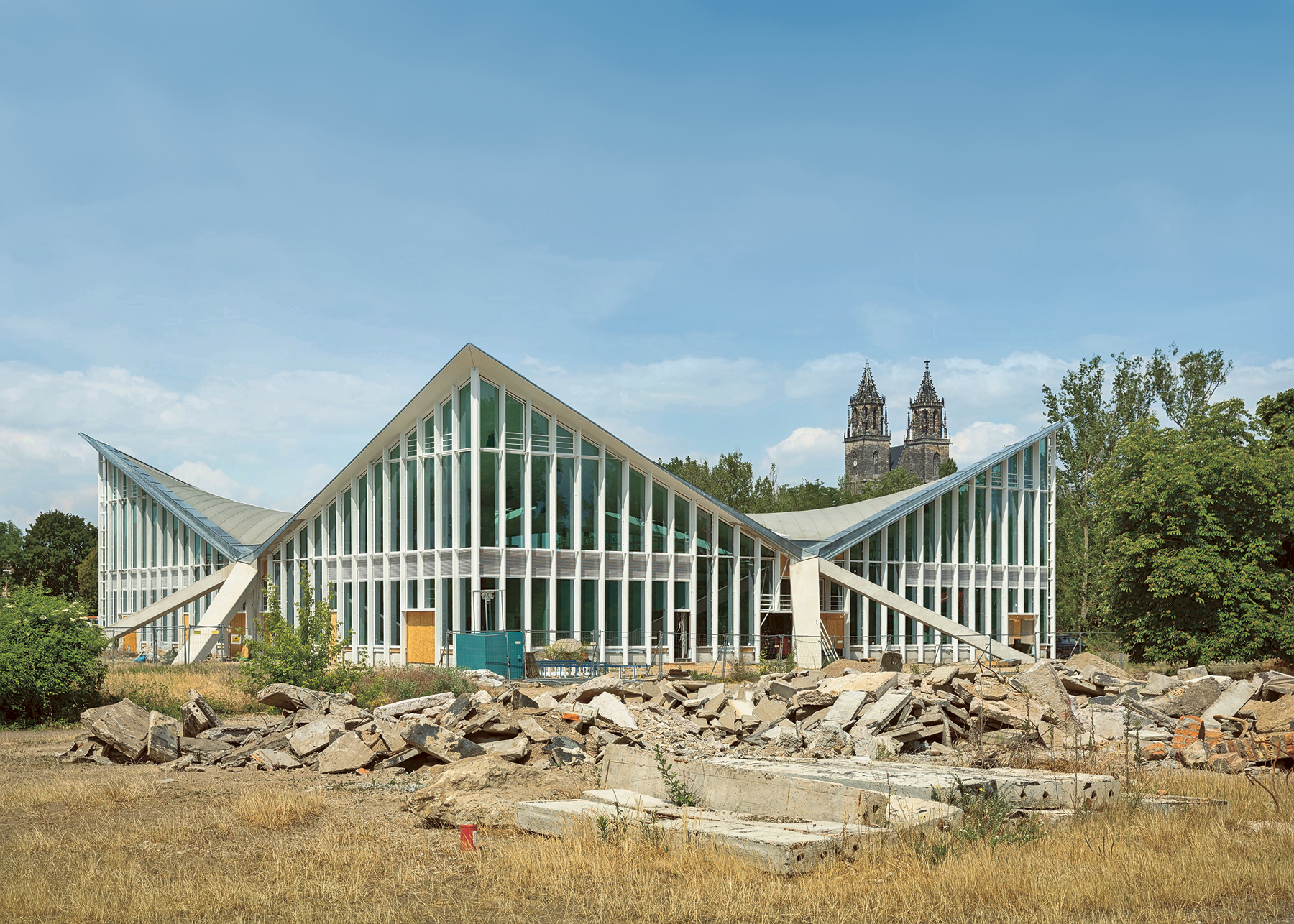
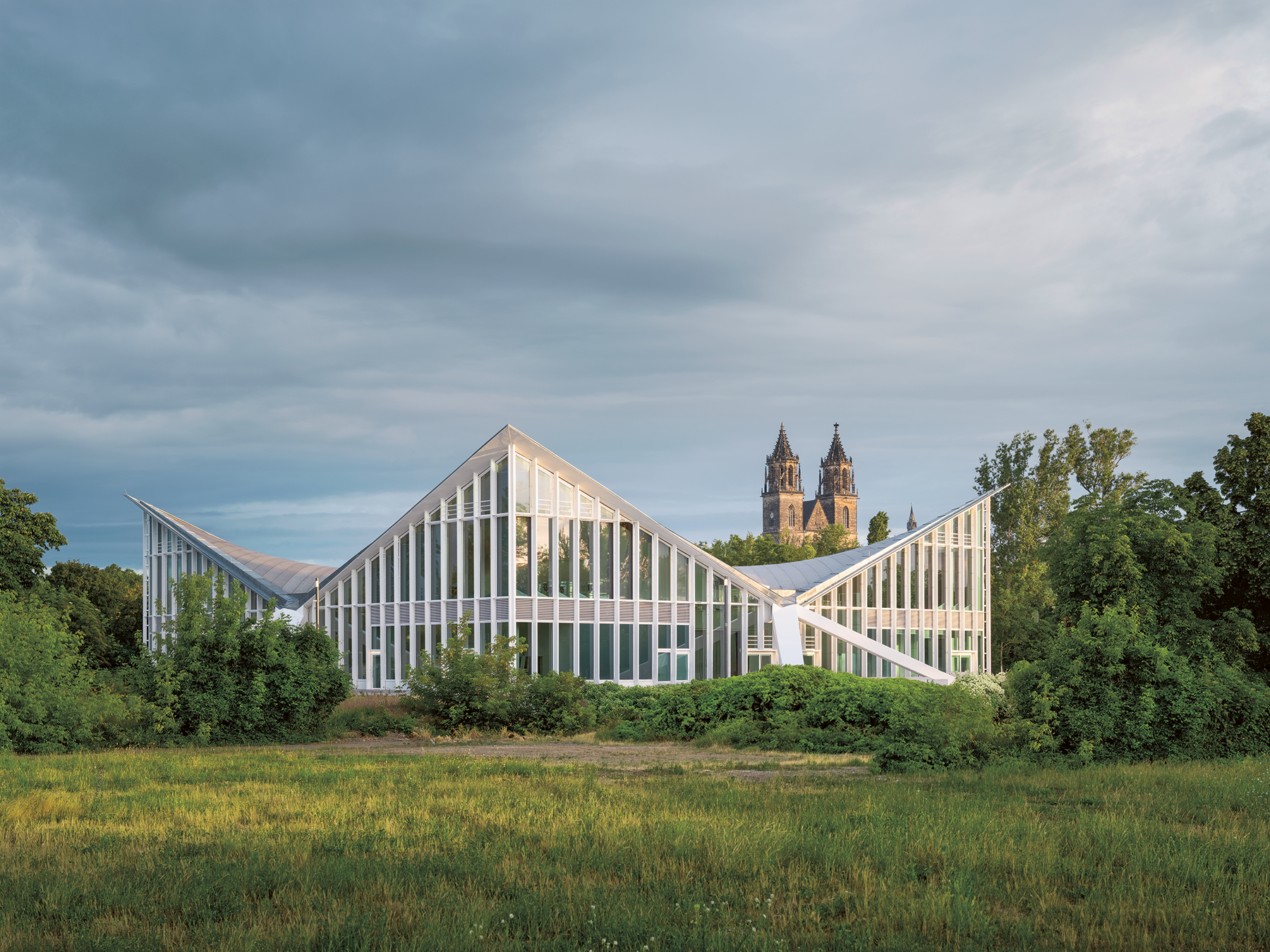
在建筑内部,大型空间按照城市的要求被灵活分割成较小的单元。我们采用了穆特正方形平面的基本体系,在大厅的四个角落分别布置了边长14.8米、高5.68米的正方平面的空间单元。这些单元在空间中独立存在,与天花板不相接,这使穆特设计的建筑结构的大弧度曲线仍然清晰可见。每个空间单元均设独立的入口和出口,与外立面相连,最大程度地提升了其使用灵活性。内部则通过幕布、移动墙等元素互相组合,也可以与它们之间的通道区域组合在一起。中间区域在顶部保持开放,就像上面的天窗一样,在大厅中部聚合成305平方米的中央空间。从这里到大厅天花板和天窗的视线一览无遗。此外,四个空间单元的屋顶是可通行的,并通过通道连接在一起,形成一个夹层回廊。站在回廊上,乌尔里希·穆特的大弧度屋顶的宏伟姿态依然可见,人们甚至可以无限接近屋顶。
The city wanted a flexible division of the large interior space into smaller units. We replicated Müther’s basic squarebased system and positioned four square room boxes — each with an edge length of 14.8 meters and a height of 5.68 meters — in each of the four corners of the hall. These boxes are free-standing and are not connected to the ceiling, thus leaving the broad sweep of Müther’s construction visible. Each of these four rooms has a separate entrance and exit in the exterior facades in order to maximize flexibility for their users. Indoors, the rooms can be combined with one another and with the broad access corridors between them by means of curtains and sliding walls. These intermediate zones remain open to the roof, thus leaving an unobstructed view of the hall ceiling. Like the fenestration bands, they come together in the center of the hall to form a 305-square-meter central room. It’s always possible to look up at the ceiling and the star-shaped skylight from the hall. The roofs of the four room boxes can also be traversed and are interconnected via bridges, thus creating a cohesive gallery level from which the massive gesture of Ulrich Müther’s curved roof not only remains visible, but visitors can also get closer to the roof than ever before.

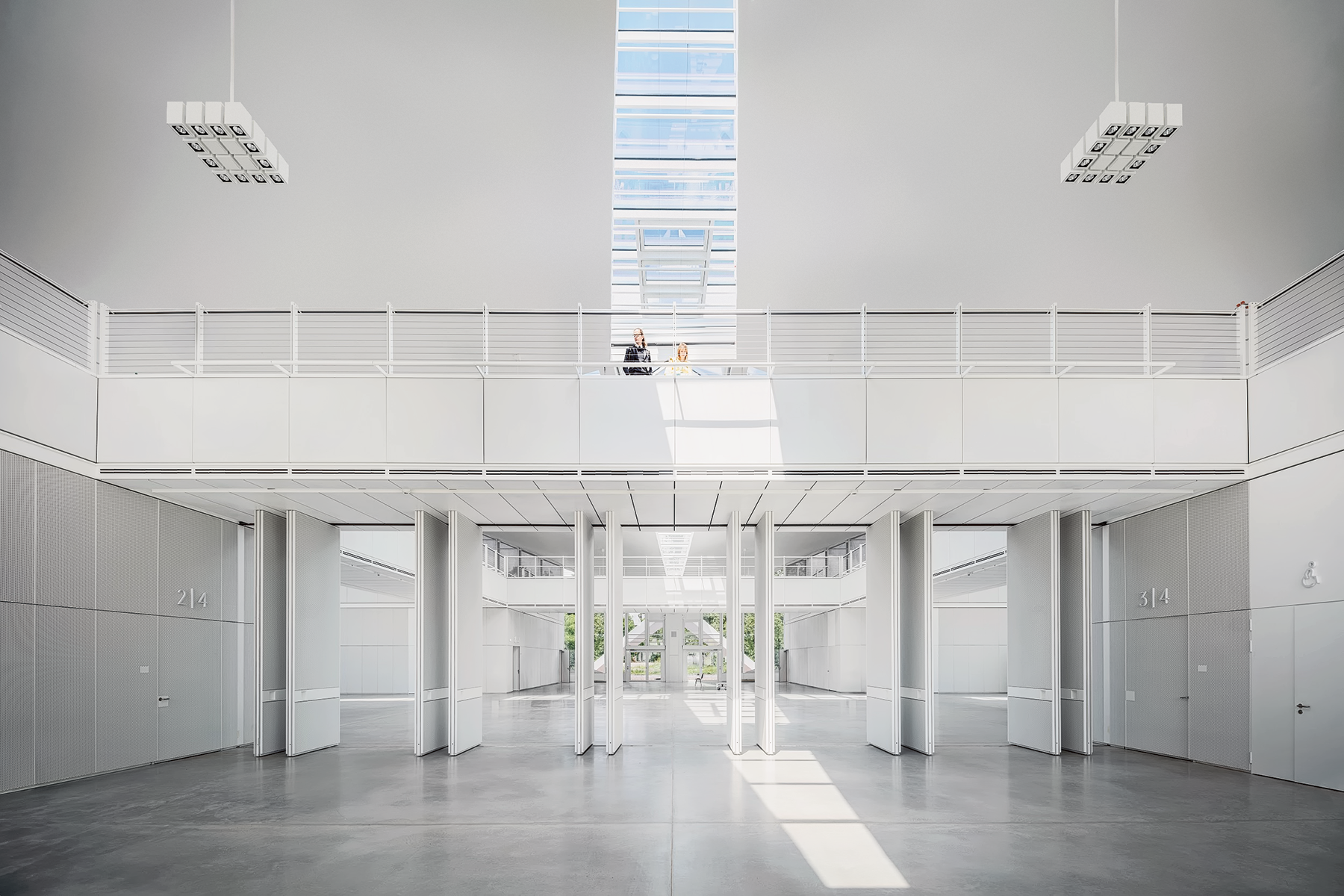
最终,通过采用最新的建筑技术手段,修缮改造设计在忠于穆特1969年原作的基础上进行持续优化,满足了当今马格德堡城市的需求。同时,由于外立面也进行了优化,半透明的工业玻璃被透明玻璃幕墙所取代,建筑比以前更加明亮。现在,穆特设计的大厅四面透光,视野开阔,成为公园中一座璀璨夺目并且极具吸引力的单体建筑。我们的建筑改造并不是对原建筑的复原,而是优化,是根据原创者乌尔里希·穆特的理念进行的升级。
Ultimately, use of the latest architectural processes made it possible to take Müther’s design from 1969 and optimize it in a way that was true to the original and durable, while also rendering it conveniently suitable for the current requirements of the City of Magdeburg. At the same time, the building is more transparent than ever because the exterior facades were also optimized, replacing the translucent industrial glass with a transparent glass facade. As a result, Müther’s hall is now light-permeable and offers views in all directions, making it a free-standing, brilliantly radiant, and inviting object in the park. Our conversion isn’t just a reconstruction of the original hall. It’s an improved version — an update in line with its inventor, Ulrich Müther.
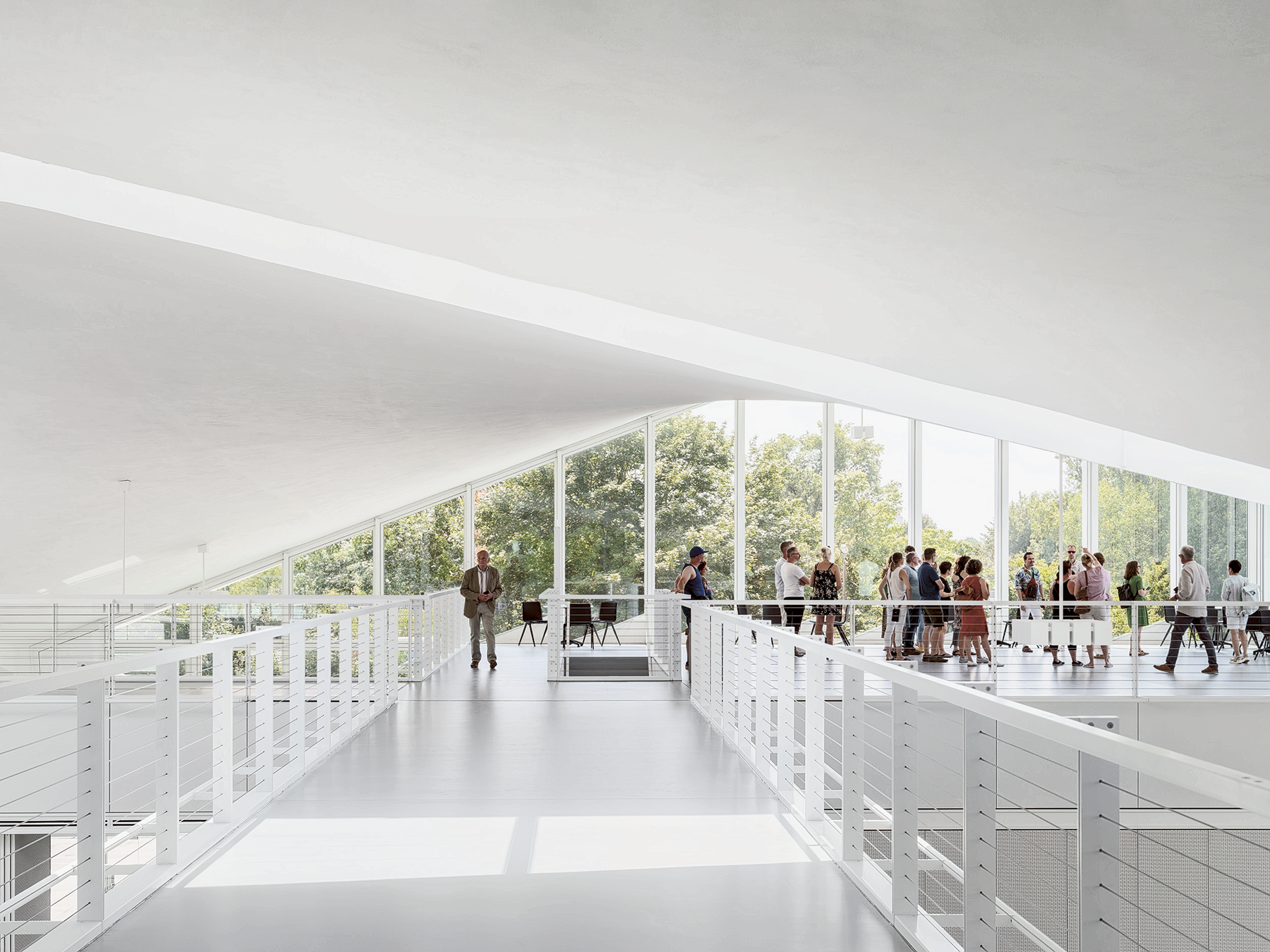
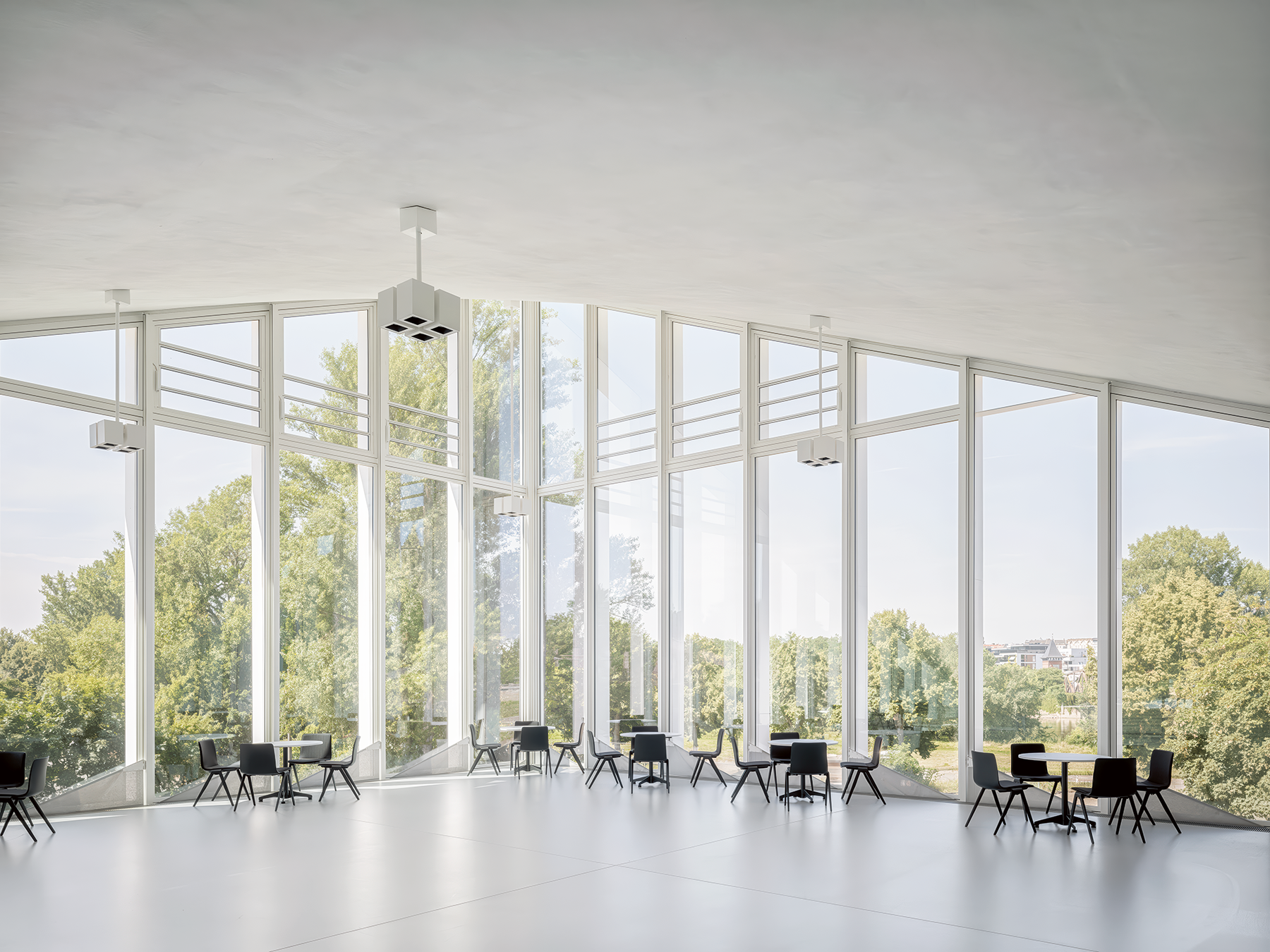
设计图纸 ▽
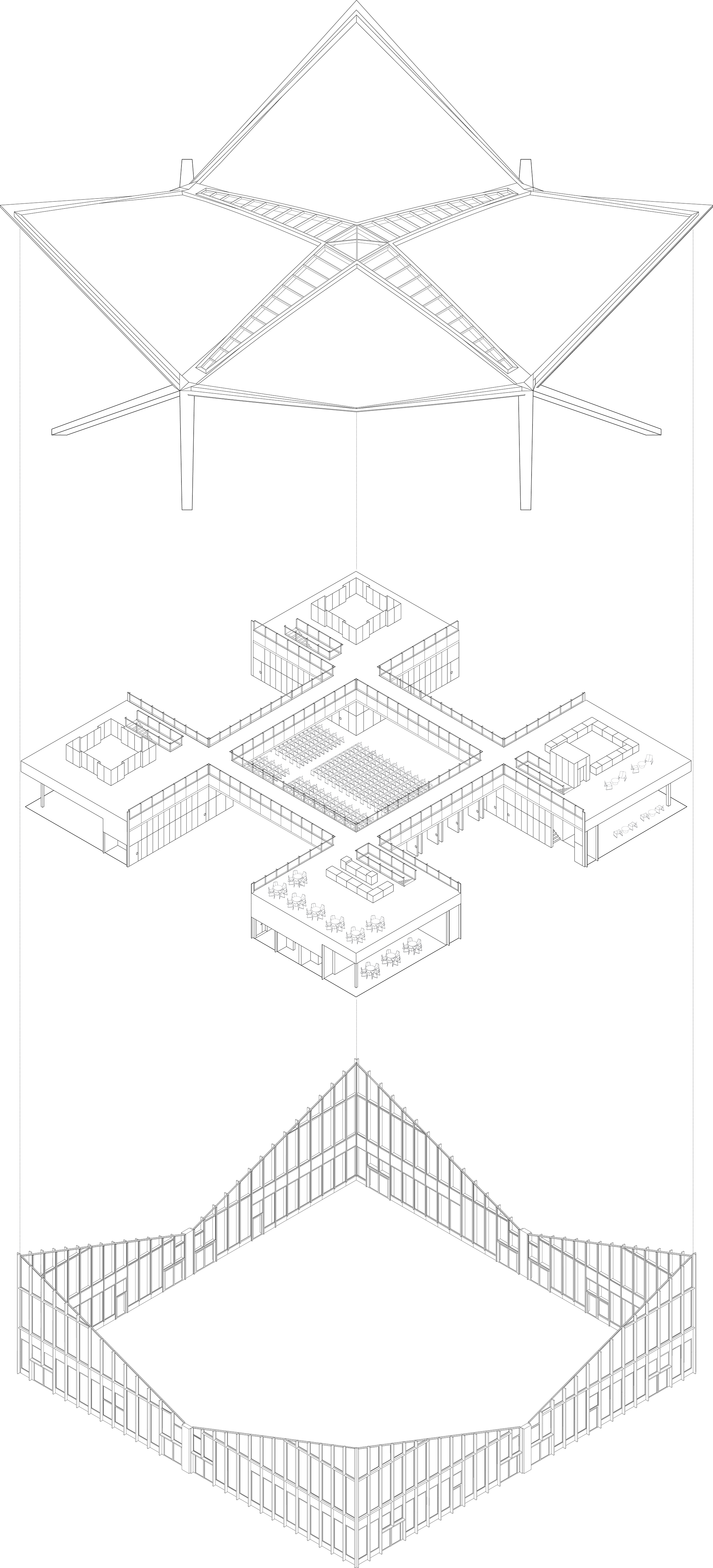
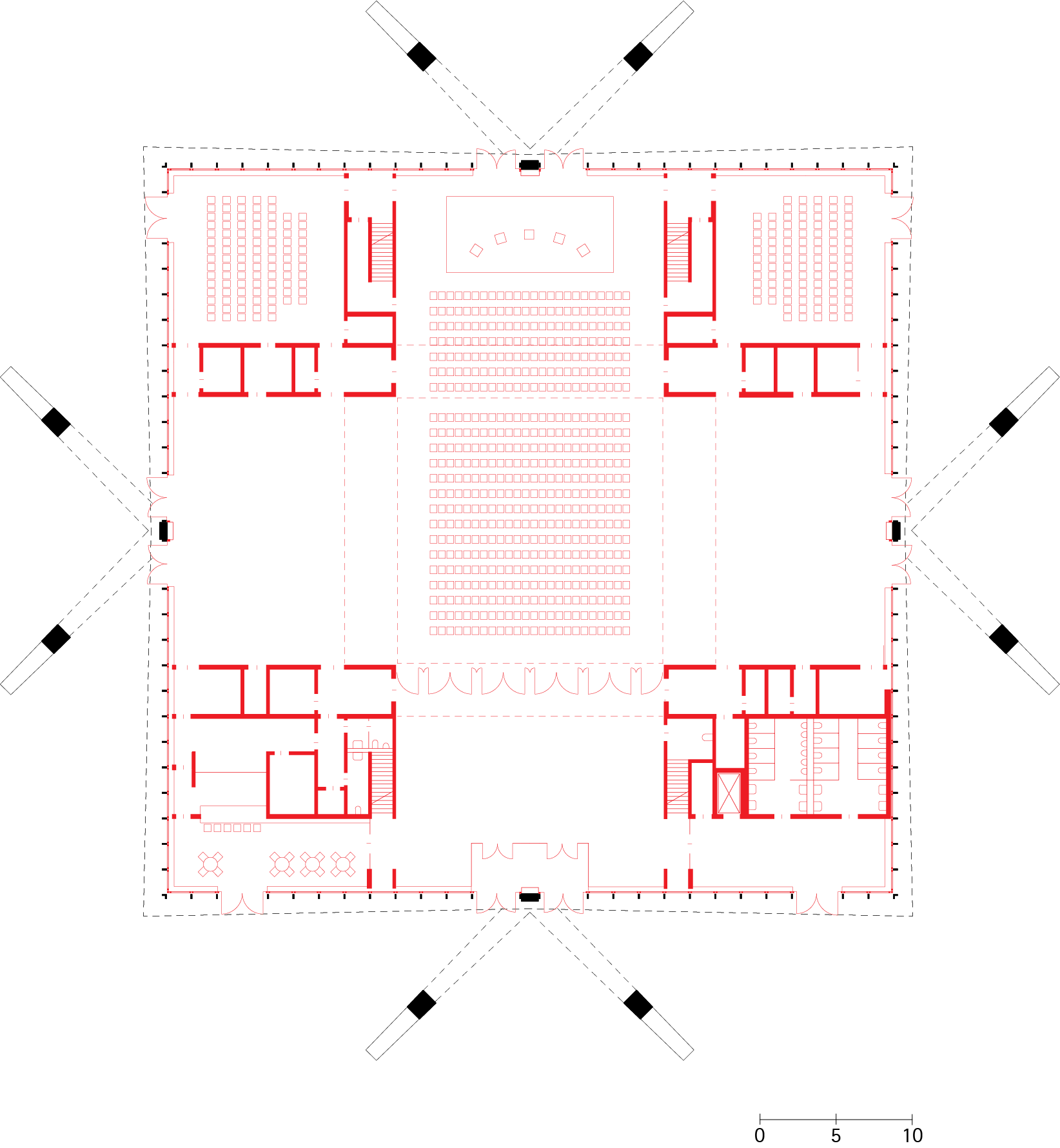


项目信息
马格德堡双曲面壳体屋顶建筑
德国
2024年
业主:州府马格德堡市
1969年设计:乌尔里希·穆特
版权声明:本文由gmp授权发布。欢迎转发,禁止以有方编辑版本转载。
投稿邮箱:media@archiposition.com
上一篇:《人生切割术》里的建筑学
下一篇:gmp改造类新作:上海之禾卡纷花园